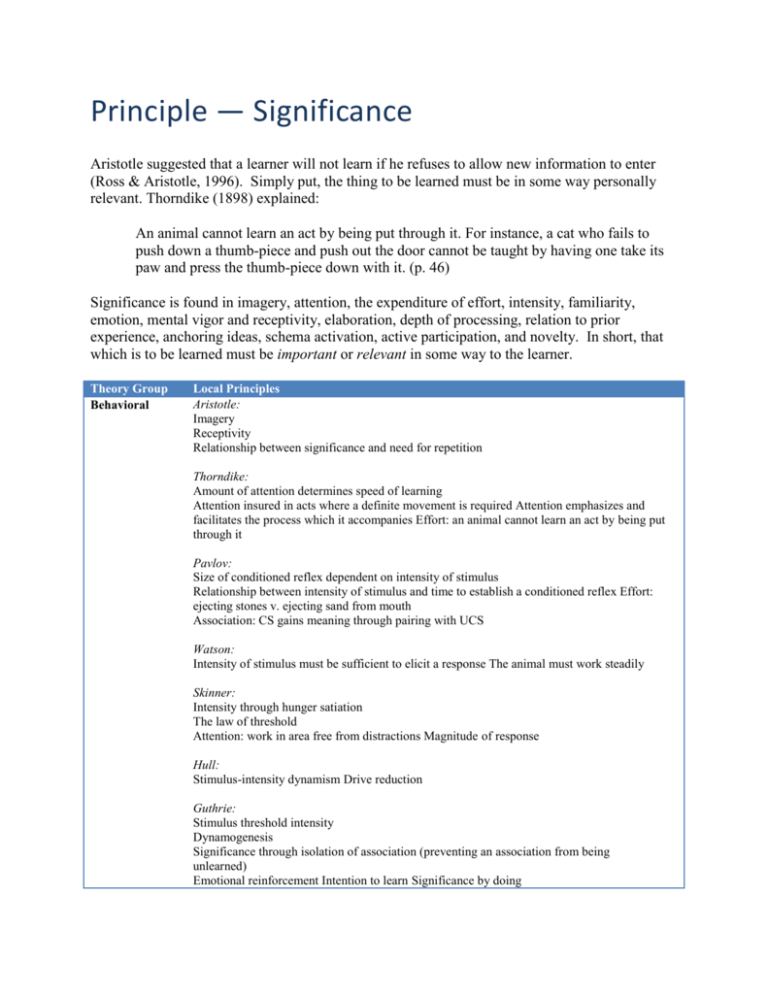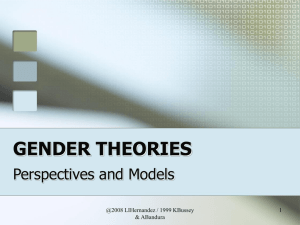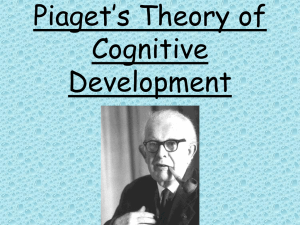Significance_overview
advertisement

Principle — Significance Aristotle suggested that a learner will not learn if he refuses to allow new information to enter (Ross & Aristotle, 1996). Simply put, the thing to be learned must be in some way personally relevant. Thorndike (1898) explained: An animal cannot learn an act by being put through it. For instance, a cat who fails to push down a thumb-piece and push out the door cannot be taught by having one take its paw and press the thumb-piece down with it. (p. 46) Significance is found in imagery, attention, the expenditure of effort, intensity, familiarity, emotion, mental vigor and receptivity, elaboration, depth of processing, relation to prior experience, anchoring ideas, schema activation, active participation, and novelty. In short, that which is to be learned must be important or relevant in some way to the learner. Theory Group Behavioral Local Principles Aristotle: Imagery Receptivity Relationship between significance and need for repetition Thorndike: Amount of attention determines speed of learning Attention insured in acts where a definite movement is required Attention emphasizes and facilitates the process which it accompanies Effort: an animal cannot learn an act by being put through it Pavlov: Size of conditioned reflex dependent on intensity of stimulus Relationship between intensity of stimulus and time to establish a conditioned reflex Effort: ejecting stones v. ejecting sand from mouth Association: CS gains meaning through pairing with UCS Watson: Intensity of stimulus must be sufficient to elicit a response The animal must work steadily Skinner: Intensity through hunger satiation The law of threshold Attention: work in area free from distractions Magnitude of response Hull: Stimulus-intensity dynamism Drive reduction Guthrie: Stimulus threshold intensity Dynamogenesis Significance through isolation of association (preventing an association from being unlearned) Emotional reinforcement Intention to learn Significance by doing Theory Group Cognitive Local Principles Estes: Attention: effective stimulus elements Ebbinghaus: Mental vigor and receptivity Meaning, rhythm, rhyme, and a common language Intensity of attention and interest Tolman: Attention as 'persistence until' 'Working over' and 'elaboration' Strong appetite Kohler: Actively attending to the effort of trying Desire to obtain food Cognitive Information Processing: Active effort to encode Elaboration Deep processing Reasoning Overt response Organization, elaboration, and cognitive activity Mindless drilling vs. attentive learning Getting attention Limited attention Learner choice Attention as a filter Attention as a tuner Attention as allocation of capacity Point of attachment in consciousness Strength – significance is created through rehearsal Connecting new information to something meaningful Leveraging preexisting associations to encode new information Intensity: emotionally powerful Ausubel: Meaningful v. rote Meaning through subsumability Adequately established subsuming ideas in cognitive structure Central unifying ideas Anchoring ideas Anchorage, dissociability, and obliterative subsumption Discriminability Set (attitude) to relate new material to cognitive structure Effort and attention result from learner's perception of need Reformulate new propositions in own words Intensity: unusual vividness Intensity: primacy, uniqueness, enhanced discriminability Constructive Schema Theory: Connected: new information fit into existing schema Schema activation Structure imposed by schema on new information Schema as filter for what will be learned Schema as retrieval plan Significance of text elements depends on schema New structures are based on a backlog of experience and memories Variable binding Schema selection Understanding based on level of specificity of the activated schema General: Effort encouraged through guided questioning Learning requires extended learner effort Student participation through inquiry methods Cross domain (physical, intellection, emotional, and social) experience Intentional process of Theory Group Local Principles constructing meaning from information and experience Significance due to language, cultural, and social background Meaningful learning Possibility of application Piaget: Awareness of connections only by means of existing cognitive structures Assimilation Humanistic Social Bruner: Representing the structure of a subject in terms of the child's view Understanding fundamentals Importance of detail Discovery facilitated through prior experience and knowledge Accessibility in memory Exercise of problem solving and effort of discovery Biological Motivation: Relative significance of relief from hunger versus pain Decrease in novelty with repetition Excessive novelty may activate without organizing a direct response Freedom to Learn: Feeling Personal meaning Relevance Much significant learning is acquired through doing Learning is facilitated when the student participates responsibly in the learning process Significant learning is maximized through participation Vygotsky: Symbolic representation Response of others to one's own actions Internalization Attention and interest (in primitive stage), then relation to inner framework (fourth stage) Bandura: Attention, accurate perception, and significant features Expenditure of effort Situated learning: Commitment of time, intensified effort, more and broader responsibilities, and sense of identity Activity theory: Resolution of actual contradictions in real-world situations Cognitive apprenticeship: Knowledge in context Active participation Narratives and stories Articulating A sense of ownership, personal investment and mutual dependency







